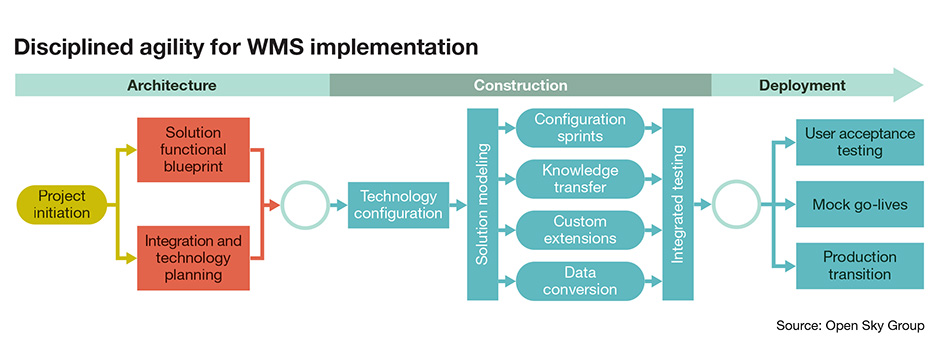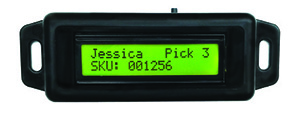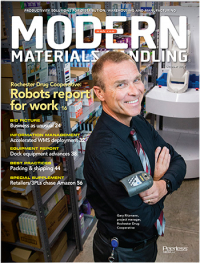Injecting agility into WMS implementation
Some companies have trimmed WMS deployment from several months to a few with process models and templates, data validation tools, and other implementation accelerators.
For all the attention on technologies like mobile robotics, warehouse execution software or smart glasses for use in distribution centers, warehouse management system (WMS) solutions remain the technology backbone for DC operations. When it comes to processes like receiving, put away, picking and shipping, in most DCs, it’s a WMS that governs those tasks.
While WMS features are evolving in areas like mobile apps, for end user companies the initial concern is how to get a WMS implemented quickly and effectively. If a company can deploy a WMS in two or three months rather than nine or 10, that’s a big win for DC operations.
WMS vendors and their consulting partners are also under pressure to deliver solutions quickly. “Often, a user company has hit some kind of business trigger—a growth pattern or an acquisition—that their current system just can’t support, so they need to move forward rapidly. So as providers, we need to be more flexible, faster and less expensive when it comes to putting a system in,” says Chad Kramlich, senior vice president of client services for Open Sky Group, a consulting firm that implements WMS and labor management system (LMS) software from JDA.
Accelerated WMS deployments involve a mix of new methodologies, process models that guide the setup of the software, development environments, and other tools and content that streamline configuration or training. WMS providers say the right methods and tools—combined with a client’s willingness to adopt a streamlined approach—can dramatically cut deployment times.
New methods
The classic implementation method, explains Kramlich, takes a “waterfall” approach in which consultants gather requirements on how a client will use the system, configure the system, gather the client data, do a full scale set up of the system, and then they begin demonstrating and testing the system. The problem with this approach, he says, is that the client must wait a long time before they see how the system will work.
“We’ve coined the term ‘disciplined agility’ for our implementation methodology,” says Kramlich. “It is a much more iterative approach than your traditional waterfall methodology. We will configure and prototype a function, show it to the client, get feedback, go back and tweak it, and then quickly show it to them again. We’re not going away for a long period of one or two months, then bringing everyone together and saying, ‘OK, here is what we’ve built.’ We have a lot of quick meetings with the customer, whether onsite or through the Web, and are demo-ing as we go.”
Open Sky’s method makes use of templates and scripts to speed up the configuration of the JDA WMS. The firm also conducts an integration workshop early in the design of the implementation process, says Kramlich, and discourages the use of unproven interfaces to the host system such as enterprise resource planning (ERP) that a WMS typically needs to integrate with. “Integration points are not something you want to be bleeding edge with,” he says. “They have to work.”
Clemens Food Group used Open Sky’s approach to deploy a Tier 1 WMS solution in a little more than five months, according to Stuart (Stu) Farber, vice president of IT for Clemens. Among the keys to hitting the desired schedule, he says, was delaying deployment of certain functions for a later project and avoiding customization of the WMS.
“If you’re having to write a whole lot of custom code, your implementation is inevitably going to take longer,” says Farber.
Clemens, a leading pork producer under the Hatfield brand, deployed JDA’s latest WMS at its Hatfield, Pa., facility that went live in January 2017. The warehouse is a high-volume, FDA-regulated facility that handles more than a million unique case IDs daily. Farber says the deployment needed to meet a relatively rapid schedule because Clemens wanted to get the WMS live before deploying a new ERP system.

Clemens is also in the process of deploying the WMS at a second, highly automated greenfield site in Coldwater, Mich., which was slated to go live in August 2017. After the second site has the WMS running, Clemens plans to deploy JDA’s labor management functionality at both sites. Other WMS functionality, such as a “scan to truck” process that improves pallet building and loading, but requires extra dock area procedures and training, was purposely delayed to speed up deployment. “A big key for us with the project was the willingness to say, ‘we’re going to delay some features,’” Farber says.
Other keys to deploying the WMS rapidly, adds Farber, were having the master data it needed tested and ready, and testing the configuration in a frequent, incremental way under Open Sky’s agile method. According to Farber, this approach was central to speeding up the project and delivering a WMS configuration that matched user expectations.
“Within the first month, we were able to see our data in the new system with some basic configuration,” Farber says. “So we could actually test the picking functionality within a month of the start, and fine tune as we went along. Within two months, we saw all the major modules [in test mode]. We were able to touch them, feel them and request changes from there.”
The right tools
While user companies need to be willing to do things like adopt standard processes when possible, vendor tools can help tailor a WMS to a company. However, vendors say it’s best to avoid customizing a WMS in a way that alters core code. Bob Kennedy, vice president of business development at DMLogic, now part of Körber group, offers a software development platform called StepLogic that automates WMS development tasks.
DMLogic has built a WMS solution using the platform, but companies may also use it to customize a third-party WMS to gain “personalizations” that sit outside the core code, explains Kennedy. “It’s a very visual platform, so it is more configuration versus software development,” Kennedy says.
Personalized apps or extensions made with the platform might include things like a unique cycle counting procedure or adding a weighing step to a picking process, says Kennedy. In other cases, customers have used StepLogic to add extra messages or product/package pictures to a radio frequency (RF) picking routine to help train new users. Some users have also used the platform to quickly create personalized packing screens to support the unique packing requirements involved with new products or customers. “Literally within minutes, you can change screen elements to incorporate the latest packing instructions,” says Kennedy.
Over the long term, flexible WMS tools help keep the deployment in sync with changing requirements, says Kennedy. “The fact is that business requirements can change very rapidly, often faster than the WMS, and a business has to support its operation, so invariably over time a gap can develop between what the software can do and what you need it to do.”
Other WMS providers agree that WMS flexibility is becoming just as important as a deep list of features and functions. “Giving users the flexibility and freedom to make the configuration changes on their own to support their business is becoming critical, simply because there are so many businesses that don’t actually know what the future holds for them in terms of fulfillment and warehouse requirements,” says Scott Deutsch, president of North America for Ehrhardt + Partner. “They want a system for which they don’t need our services team to come in to make adjustments for them.”
WMS vendor TECSYS offers a rapid deployment program for its WMS. Known as OneSprint, the offering leverages reference models and other tools and content to accelerate projects, says Bruno Dubreuil, vice president of product marketing for TECSYS.
Using its experience with how customers use the WMS, TECSYS developed standard reference models called Smart Models that help configure the software. These models, as well as standard operating procedure (SOP) documentation, training content, and testing and validation tools, allow the WMS to be deployed in two to three months, says Dubreuil. “We’ve simplified the work involved because everything is predesigned, which really helps to fast track an implementation,” he says.
Another major time saver, says Dubreuil, is that rather than a train-the-trainer approach in which the vendor educates “super users” who train the other end users, under OneSprint, the use of super users is reduced, with TECSYS implementation staff leading most of the training, says Dubreuil. This streamlined training, as well as the reference models and tools that do things like validate system rules, cut major chunks of time from projects, he says. “Testing and training are usually areas that take the most time deployments, so improving the tools and approach for these areas dramatically speeds things up,” he says.
Labor effectiveness
Getting a WMS configured and installed quickly is desirable, but ultimately, it should be an effective solution that is easy to learn, especially with the growing amount of temp labor needed in DCs. Making WMS quicker to deploy and easier to learn are key elements of WMS provider Manhattan Associates’ Performance at Work solution.
Be quick to deploy inventory with pick-to-light system
With the high level of each picking associated with e-commerce, pick-to-light (PTL) systems are becoming more popular. To make PTL and associated inventory management capabilities easier to implement, warehouse automation provider Voodoo Robotics is touting a PTL solution offered under a pay-as-you-go model.
“ The key thing is that it is a rental, month-to-month solution, which makes it low cost and really helps with seasonality,” says Trevor Blumenau, CEO of Voodoo Robotics. “It does not require a big upfront commitment, so it makes the system easily accessible to user companies.”
The key thing is that it is a rental, month-to-month solution, which makes it low cost and really helps with seasonality,” says Trevor Blumenau, CEO of Voodoo Robotics. “It does not require a big upfront commitment, so it makes the system easily accessible to user companies.”
Voodoo’s PTL tags are wireless and powered by two AA batteries, which eliminates the need to run power to the tags. The inventory management capabilities for the solution come from Voodoo’s SKU-Keeper, Cloud-based software, which can manage inventory, govern the PTLs, and provide traceability and reporting.
While Voodoo’s PTL modules can integrate with a warehouse management system (WMS) or enterprise resource planning (ERP) system, SKU-Keeper can be used to drive the PTLs and manage inventory, essentially functioning as a “WMS light” type of solution, says Blumenau.
“We have our SKU-Keeper software if they don’t have anything in place and need an inventory management solution,” Blumenau says. “For companies that have been using spreadsheets to manage inventory, our solution can be a good, quick-to-implement path for them.”
Users of SKU Keeper and Voodoo’s PTLs include The Window Outfitters, a Dallas-based manufacturer and distributor of wood and aluminum window furnishings. The company deployed 150 of the PTL units along with SKU-Keeper, using the software for inventory management and picking.
Because the PTL modules are battery powered and communicate wirelessly with a “Turbo” unit that links to the Internet, the modules can be attached to any shelf system, rack location or cart, says Blumenau. “You can purchase a standard cart with bracket or bins, attach some tags to the bins, and for a pittance, have a pick-to-light system functioning in your warehouse,” he says.
As one solution element, Manhattan has embedded basic LMS functionality within Manhattan’s “WM Open Systems” WMS so supervisors and associates can begin benefiting from labor management as soon as the WMS goes live, says Peter Schnorbach, senior director of product management for Manhattan Associates.
While the base functionality doesn’t include advanced labor functions such as the use of engineered standards, it does have core metrics on productivity by activity, employee and other measures. “We wanted to remove the silo approach of getting into LMS deployment separate from WMS,” he says. “We believe it’s important to know right from the start how well your people are performing: Are they moving at a good pace and using their time efficiently?”
Manhattan also added workflows into the LMS functionality that automatically serve up needed trends for supervisors, says Schnorbach, as well as apps that provide feedback to employees on their recent performance, much like the consumer apps you get with a fitness tracker.
Open Sky’s Kramlich says that in his experience, when LMS is delayed by choice, it typically is desirable to set up the needed data points when configuring the “warehouse map” for the WMS. Then when LMS is turned on, the data is there and the focus can be on training.
With more DC operations involved in e-commerce and the processing of small items and orders, making labor more effective from day one of a WMS deployment is growing in importance, concludes Schnorbach. “The smaller the units of measure you are processing, the more important it is to immediately use labor management to drive effectiveness across your workforce,” he says.
Companies mentioned in this article:

Article Topics
Storage News & Resources
Walmart chooses Swisslog AS/RS and software for third milk processing facility Steele Solutions showcases advanced structural steel platforms and materials handling chutes HWArobotics delivers advanced AS/RS technology to e-commerce specialist Darwynn Frazier shows Pallet Spacing System and Method Steel King Industries announces strategic collaboration with Automha Americas Kardex FulfillX for AutoStore can help businesses meet goals in under 6 months The Stow Group puts the spotlight on its Movu Robotics brand More StorageLatest in Materials Handling
Registration open for Pack Expo International 2024 Walmart chooses Swisslog AS/RS and software for third milk processing facility NetLogistik partners with Vuzix subsidiary Moviynt to offer mobility solutions for warehouses Materials Handling Robotics: The new world of heterogeneous robotic integration BSLBATT is looking for new distributors and resellers worldwide Lucas Watson appointed CSO for Körber’s Parcel Logistics business in North America Hyster recognizes Dealers of Distinction for 2023 More Materials HandlingAbout the Author
Subscribe to Materials Handling Magazine

Find out what the world's most innovative companies are doing to improve productivity in their plants and distribution centers.
Start your FREE subscription today.
April 2024 Modern Materials Handling

Latest Resources












